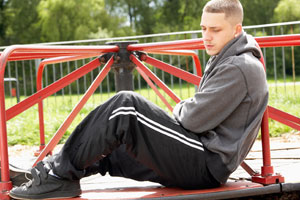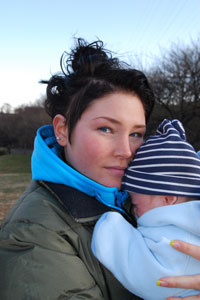The Beat
 With school back in session soon, this could come in handy: A new brief from the National Center for Homeless Education aims to help educators and service providers understand the federally funded education programs for migrant and homeless youth, so that young people eligible for both types of services are able to get assistance.
With school back in session soon, this could come in handy: A new brief from the National Center for Homeless Education aims to help educators and service providers understand the federally funded education programs for migrant and homeless youth, so that young people eligible for both types of services are able to get assistance.
The brief includes short explanations of the Migrant Education Program and the Education for Homeless Children and Youth Program, both authorized by sections of the Elementary and Secondary Education Act. You'll also find a list of terms that the two programs use to refer to young people, the different criteria they use to decide if youth are eligible for services, and a profile of the ways the two programs collaborate in Polk County, FL.
Read the brief: "Migrant Students Experiencing Homelessness: Rights and Services Under the McKinney-Vento Act"
More From NCFY
 Welcome to part 2 of our series on planned giving, a category of philanthropy that includes bequests, gifts of stock, trusts and other more complicated ways of giving money.
Welcome to part 2 of our series on planned giving, a category of philanthropy that includes bequests, gifts of stock, trusts and other more complicated ways of giving money.
In the first installment, fundraising consultant and blogger Gail Perry told NCFY that people make larger contributions when they make planned gifts, compared to when they give an out-of-pocket cash gift. And Nanci Leitch, a fundraiser at the nonprofit Youth Services in Brattleboro, VT, told us that youth-serving agencies have a perfect mission for planned giving. We also shared a checklist to help you decide if promoting planned giving is a good step for your organization.
Now, we’d like to share three strategies, suggested by Perry and Letich, for making planned giving part of a youth-serving organization’s fundraising efforts. You may choose to combine the strategies, or just start with one.
Strategy 1: Use what you’ve got. Promoting planned giving can be as easy as adding a few sentences or paragraphs to your newsletter or annual report, Leitch says. You might profile donors who’ve made a bequest to your organization, or share the legal language people can put in their wills if they want to make a bequest.
Strategy 2: Target your old faithfuls. “People who are going to make a bequest are people who are already giving you consistent amounts of money,” Perry says. She recommends searching your fundraising database for people who’ve given regularly over the past ten years, no matter how small the donation.
Once you’ve made a list of candidates, Perry says, send them a letter letting them know how easy it is to benefit your organization by writing it into their wills, and inviting them to call you to discuss the details.
Strategy 3: Cast a wide net. Leitch says most of Youth Services’ bequests have come from people who weren’t already donors. So she takes an approach to planned giving that's different from Perry's.
Youth Services uses donated ad space in the local newspaper to run spots featuring photos of people who have made bequests. The organization also offers quarterly estate planning seminars to lawyers in the Brattleboro area. By attending the events held in Youth Services’ conference room and sponsored by a local trust company (which foots the lunch bill), lawyers get continuing education credits. And Youth Services’ executive director has an opportunity to tell them about the organization, in hopes that they’ll recommend the organization to clients looking to do good in their wills.
“People might not know about us, but they know they want to make a difference for children and youth,” Leitch says.
Read part 1 of this series to find out if planned giving is a good fit for your organization.
 The U.S. Department of Health and Human Services' Office of Adolescent Health promotes evidence-based approaches to teen pregnancy prevention. To help practitioners, parents and the general public better understand teen pregnancy trends and prevention strategies, OAH has recently unveiled a series of Web pages on teen pregnancy and childbearing.
The U.S. Department of Health and Human Services' Office of Adolescent Health promotes evidence-based approaches to teen pregnancy prevention. To help practitioners, parents and the general public better understand teen pregnancy trends and prevention strategies, OAH has recently unveiled a series of Web pages on teen pregnancy and childbearing.
The Web pages include information on:
- Trends in U.S. teen pregnancy and child birth
- Strategies for preventing teen pregnancy
- Ways to engage young men in pregnancy prevention
- Tips for parents
Go to the Teen Pregnancy and Childbearing section of the OAH website.
More From NCFY
 “Protective Factors Associated with Fewer Multiple Problem Behaviors Among Homeless/Runaway Youth” (abstract). Journal of Clinical Child & Adolescent Psychology, Vol. 40, No. 6 (2011).
“Protective Factors Associated with Fewer Multiple Problem Behaviors Among Homeless/Runaway Youth” (abstract). Journal of Clinical Child & Adolescent Psychology, Vol. 40, No. 6 (2011).
What it’s about: In studies of risky behavior among homeless youth, many young people have said they use drugs, trade sex for money or drugs and engage in other risky sexual behaviors, and get in trouble with the law by doing things like using a gun or knife or shoplifting. What's more, these behaviors are usually linked. To see if better planning and problem-solving skills would help youth avoid all three risky behaviors at once, the authors studied nearly 500 homeless 12- to 24-year-olds in Los Angeles.
Why read it: We know a lot about the risks that homeless youth take. But researchers and service providers are still exploring what programming might work best to help homeless young people choose less harmful paths. This study adds to the research on what works.
Biggest takeaway for youth workers: The authors found that youth who had learned to set goals, make good decisions and cope with problems on their own were less likely than their peers to behave in more than one risky way. That difference held true even among those who reported more homeless episodes and those who had been on the streets longer.
Interestingly, the skills didn’t affect problem behaviors individually. Rather, each of the protective factors—setting goals, making healthy decisions and directly addressing rather than escaping from problems—reduced all three risky behaviors studied.
The authors conclude that teaching youth to solve problems and plan ahead are critical steps programs can take to keep young people from getting in trouble and coming to harm.
Additional references: The researchers used a variety of scales to measure different variables in this study that might be useful in screening and assessment of youth, including the following:
- Self-Perception Profile for Adolescents
- Adolescent Perceived Microsystem Scale
- Goal Setting Skills Scale
- Decision Making Skills Scale
- Adolescent Coping Orientation for Problem Experiences
(Publications discussed here do not necessarily reflect the views of NCFY, FYSB or the Administration for Children and Families. Go to the NCFY literature database for abstracts of this and other publications.)
 Sixteen percent of births to teenagers occur in communities with low-performing schools. And many of the teen parents are high-school dropouts. A new report released by the National Campaign to Prevent Teen and Unplanned Pregnancy and America's Promise Alliance explores the relationship between teen pregnancy and dropping out of school and identifies some of the ways programs across the country are working to combat the two together.
Sixteen percent of births to teenagers occur in communities with low-performing schools. And many of the teen parents are high-school dropouts. A new report released by the National Campaign to Prevent Teen and Unplanned Pregnancy and America's Promise Alliance explores the relationship between teen pregnancy and dropping out of school and identifies some of the ways programs across the country are working to combat the two together.
Some findings the report highlights include:
- Parenthood is a leading reason teen girls drop out of school. Thirty percent of girls who have dropped out of high school cite pregnancy or parenthood as a key reason. The rate is slightly higher for minority students: 36 percent of Hispanic girls and 38 percent of African American girls.
- One in three teen mothers earns neither a diploma nor a GED, compared with six percent of young women who have not given birth.
- Less than two percent of young women who have a baby before age 18 attain a college degree by age 30.
The study also highlights some of the innovative ways by which programs across the country are addressing teen pregnancy prevention and school completion. Several school districts, including New York City Public Schools, found that parental objections to teen pregnancy prevention programs in schools was a barrier, and organized an informational campaign for parents to garner their support. In West Virginia the state school system found that teachers needed support in delivering accurate and engaging pregnancy prevention information, and partnered with the health department and local organizations to hold in-person and online professional development courses for teachers.
More From NCFY About Teen Pregnancy and Parenthood
"Primary Sources: Improving the Future for Pregnant and Parenting Youth"
"Reaching Out to Young Mothers to Prevent Subsequent Pregnancies"
"Housing Young Families Together to Promote Permanent Connections"
 Gail Perry has two charities in her will: Her church and her alma mater. The fundraising consultant and blogger from Raleigh, NC, says she exemplifies a simple fact of philanthropy: People who have a long history with an organization are very likely to leave money to it in their wills, even if they only give a small amount every year.
Gail Perry has two charities in her will: Her church and her alma mater. The fundraising consultant and blogger from Raleigh, NC, says she exemplifies a simple fact of philanthropy: People who have a long history with an organization are very likely to leave money to it in their wills, even if they only give a small amount every year.
“People tend to make bigger gifts via planned giving,” she says, referring to a type of philanthropy that encompasses bequests, gifts of stock, trusts and other more complicated ways of donating money.
Perry says planned giving is key to long-term financial stability. “The way endowments get built is through planned gifts,” she says. “If you need money right away, planned giving is not the right strategy.”
A Good Fit for Youth-Serving Organizations
Perry says that while most small to medium-sized organizations can ignore the complex giving tools under the planned giving umbrella, they shouldn’t miss a chance to invite donors to leave money to the organization in their wills.
That’s especially true because people who leave bequests to charity want to be remembered and have a long-term impact, according to research funded by the Association of Fundraising Professionals. Nanci Leitch, director of development and communication at Youth Services, a nonprofit in Brattleboro, VT, says the mission of youth-serving organizations can be a perfect match for those sorts of people.
“People who make planned gifts to Youth Services are people who believe in the organization, maybe were on the board or have no kids of their own, and want to leave a legacy that impacts the kids of the future,” she says.
Based on Perry’s advice, we’ve created a checklist you can use to decide whether planned giving is right for your youth-serving organization. We’ll share that today, and next week we’ll share Perry and Leitch’s easy, low-cost ideas for promoting planned giving.
Is Planned Giving Right for Your Organization?
If the following statements are true about your organization, encouraging planned giving among your donors could be a good step toward building your endowment:
The organization is at least 10 to 15 years old.
The organization has credibility in your community. People trust your work.
You raise money from individuals.
You have at least one dedicated fundraiser on staff.
You have “major donors” who give four figures or more to the organization.
You have donors who have given for a long period of time (say, five years or more).
You have a fundraising database to track donors and their giving.
More Information
Get five simple planned giving tips from Perry's blog, Fired-Up Fundraising.
Learn why people leave bequests according to research funded by the Associate of Fundraising Professionals.
Test your knowledge of fundraising in a short NCFY quiz.
 The deadline for FYSB's essay contest for runaway and homeless youth is about a month away. To help you and your youth get writing, we're re-posting this 2010 article about running a writing workshop.
The deadline for FYSB's essay contest for runaway and homeless youth is about a month away. To help you and your youth get writing, we're re-posting this 2010 article about running a writing workshop.
Everybody has a story to tell. That’s the underlying philosophy of youth writing workshops: giving young people the opportunity to be heard and the confidence to express their thoughts.
In particular, youth from underserved communities benefit from the chance to speak out, says Paige McBee, outreach coordinator for Streetside Stories, a San Francisco nonprofit that offers storytelling, creative writing and filmmaking workshops to middle school and high school students. “The underserved tend not to be represented in the larger conversation, culturally,” she says. Learning to write well enables young people to enter into public discussions, for instance by writing letters to the editor or to their members of Congress or by reading their poetry in front of an audience.
Writing can also be a therapeutic tool. The New York City division of Green Chimneys, a youth social services organization and Family and Youth Services Bureau grantee, uses workshops, in part, to help lesbian, gay, bisexual, transgender and questioning youth come to terms with difficult experiences, says Theresa Nolan, director of the New York City division. LGBTQ youth “end up with a lot of pain which is hard to verbalize,” Nolan says, and writing workshops are supportive places to process their emotions.
Strong writing skills are also valuable tools for the future, whether youth are writing college essays or applying for jobs. “It’s not about poetry,” says Jonathan Tucker, a slam poet and freelance workshop facilitator in Washington, DC. “It’s about giving people what they need to deal with the world.”
When bringing a writing workshop to your program, here are some things to consider:
Make it fun. “I start workshops with theater, improv, word association—not writing. Writing is school,” Tucker says. “Every kid wants to have fun, so have fun playing with words.”
Create trust by sharing your own stories. On the first day of a storytelling workshop, Streetside Stories’ facilitators, who are professional writers and media artists, tell a story drawn from their own lives, McBee says. Young people will feel more comfortable committing their thoughts to paper and receiving feedback after they’ve heard facilitators reveal something about themselves.
Let youth set the tone. “Listen to the young people and how they want to utilize the program—what style of writing, how it will be shared, how to structure it,” Nolan says. “Don’t make it top down—start where the students are.”
Honor young people’s voices. Don’t censor youth. Instead, Tucker says, “Make sure they know ‘whatever you say has power.’ If they want to stand up and talk about how much they dislike a teacher—that’s expression.”
Work towards creating a finished project. Programs at Streetside Stories almost always end with a finished product, such as a newspaper, book or film, McBee says. This teaching model, known as project-based learning, encourages students to collaborate and make creative decisions, and gives them ownership over the learning process. Every youth has the opportunity to present or publish work, either at a year-end event, in a self-published booklet or in a bound anthology.
 We're re-posting a piece we published last December about youth crisis hotlines, because it turns out, summer is a time many youth find themselves on the streets. You might also be interested in reading about how two crisis lines funded in part by the Family and Youth Services Bureau keep their lines open no matter what.
We're re-posting a piece we published last December about youth crisis hotlines, because it turns out, summer is a time many youth find themselves on the streets. You might also be interested in reading about how two crisis lines funded in part by the Family and Youth Services Bureau keep their lines open no matter what.
Many communities report a spike in the number of youth who run away as the holidays approach, due to conflict at home and problems at school. "The first part of the holidays, the number of young people running away seems to go down, because kids and families really want to be together and make it work," says Susan Harmon of National Safe Place, a network of organizations working to keep young people off the streets. "But then the stressors come back, and we do see more youth running away."
The National Runaway Switchboard, a hotline for youth and those who care about them, gets the most calls from youth in crisis during the summer, says Gordon Vance, NRS's director of services, not in the cold of winter. Still, he says the Switchboard does see an uptick in youth calling from the streets around the new year. "When school's out, young people lose a lot of the people around them who they'd go to if they need something," he says, which forces them to seek help elsewhere.
Should young people find themselves on the streets this holiday season, or at any other time of the year, having a few numbers saved in their phones can help them find safety and support quickly.
- National Safe Place's Txt 4 Help: When youth text the word SAFE and their current location (street address, city and state) to the number 69866, they'll receive the address of the nearest Safe Place site and a phone number for the local youth shelter.
- The National Runaway Switchboard: Youth can call 1-800-RUNAWAY or chat live on the NRS website for confidential support and referrals to service providers. They may also qualify for a free bus ticket home.
- The Trevor Project, Lifeline and TrevorChat: Youth who are feeling alone, confused or in crisis can call 1-866-488-7386 or chat online with a trained advocate. The Trevor Project provides crisis intervention and suicide prevention services to lesbian, gay, bisexual, transgender and questioning youth.
 Family conflict often lies at the heart of a young person's homelessness. So it makes sense that helping youth and their families get along is one of the most important and challenging aspects of preventing and addressing youth homelessness. The National Alliance to End Homelessness in June held a webinar on "family intervention" as a tool for building relationships and increasing stability for homeless youth. Speakers André C. Wade, program and policy analyst with NAEH, Tania Pryce, director of outreach for Youth Services of Tulsa, and Norweeta Milburn, a researcher at UCLA's Semel Institute for Neuroscience and Human Behavior, talked about:
Family conflict often lies at the heart of a young person's homelessness. So it makes sense that helping youth and their families get along is one of the most important and challenging aspects of preventing and addressing youth homelessness. The National Alliance to End Homelessness in June held a webinar on "family intervention" as a tool for building relationships and increasing stability for homeless youth. Speakers André C. Wade, program and policy analyst with NAEH, Tania Pryce, director of outreach for Youth Services of Tulsa, and Norweeta Milburn, a researcher at UCLA's Semel Institute for Neuroscience and Human Behavior, talked about:
- The practices included in family intervention, such as family reunification, family connecting, family finding and aftercare
- Examples of evidence-based family interventions
- Support to Reunite, Involve and Value Each Other, or STRIVE, a short, evidence-based family intervention model
You can view the webinar slides on NAEH's website.
More From NCFY
The story of a reunited father and daughter
How some runaway and homeless youth programs work with families to overcome abuse
A look at recent research on STRIVE
 “Impact of Running Away on Girls’ Pregnancy” (abstract). Journal of Adolescence, Vol. 35, No. 2 (April 2012).
“Impact of Running Away on Girls’ Pregnancy” (abstract). Journal of Adolescence, Vol. 35, No. 2 (April 2012).
What it’s about: The authors wanted to know whether girls who run away were more likely than other girls to become pregnant during their teen years. They studied more than 5,000 girls who participated in the National Longitudinal Study of Adolescent Health, known as Add Health, in 1995 and 1996, and who were not pregnant in 1995. Participants had answered questions about school, their families, their sexual health and experiences, and other aspects of their lives.
Why read it: Some research suggests that adolescent girls who live on their own are more likely to engage in risky sex than those who live with a family or in an institution, like a group home. Girls who become pregnant may also be more likely to get sexually transmitted diseases or to get pregnant again. Programs that prevent girls from running away may also help keep them from having these problems.
Biggest takeaway for youth workers: Running away more than doubled a girl’s chances of teen pregnancy in the year following her run. Other factors that appear to increase the odds of a teen pregnancy for young women include being sexually victimized, having romantic relationships, and not being engaged at school.
The findings suggest that it may be a good idea to coordinate teen pregnancy prevention efforts with programs that aim to prevent youth from running away. Similarly, reaching out to young women who seem to be at risk for a range of dangerous behaviors, before or after they run away, may help to prevent pregnancy.
Additional references: The National Longitudinal Study of Adolescent Health (Add Health) began in 1994. It originally looked at the ways social contexts—friends, family, neighborhood, school, romantic relationships—influence teen health. Now, it is studying health in young adulthood.
Let’s Talk is an evidence-based runaway prevention curriculum from the National Runaway Switchboard.
NCFY’s “A New Push for Teen Pregnancy Prevention” looks at advances in the teen pregnancy prevention field and approaches for working with boys and teen moms on pregnancy prevention.
(Publications discussed here do not necessarily reflect the views of NCFY, FYSB or the Administration for Children and Families. Go to the NCFY literature database for abstracts of this and other publications.)


 Subscribe to RSS Feed
Subscribe to RSS Feed

 Sign up
Sign up Follow us
Follow us Like us
Like us Sign up for our RSS feeds:
Sign up for our RSS feeds: 

